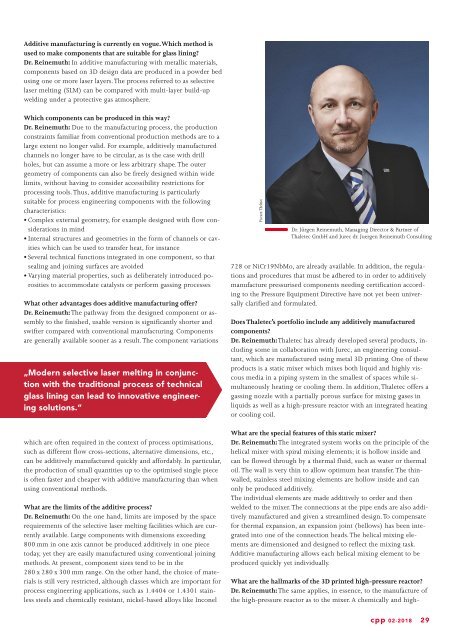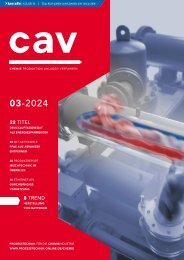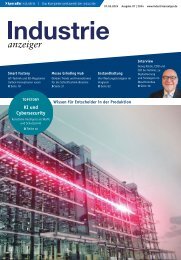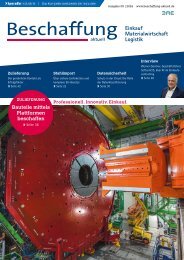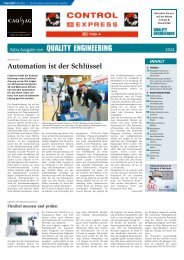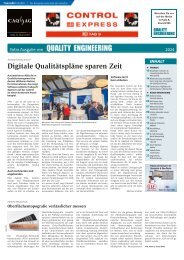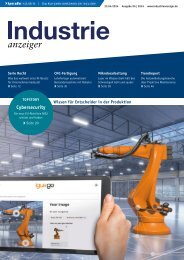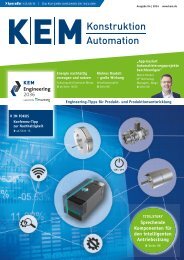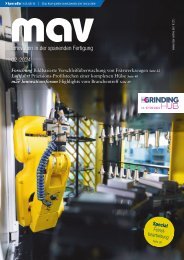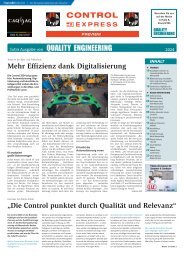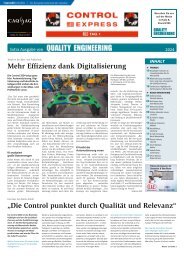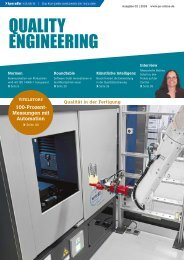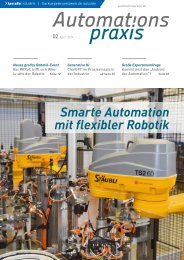cpp - Process technology for the chemical industry 02.2018
You also want an ePaper? Increase the reach of your titles
YUMPU automatically turns print PDFs into web optimized ePapers that Google loves.
Additive manufacturing is currently en vogue. Which method is<br />
used to make components that are suitable <strong>for</strong> glass lining?<br />
Dr. Reinemuth: In additive manufacturing with metallic materials,<br />
components based on 3D design data are produced in a powder bed<br />
using one or more laser layers. The process referred to as selective<br />
laser melting (SLM) can be compared with multi-layer build-up<br />
welding under a protective gas atmosphere.<br />
Which components can be produced in this way?<br />
Dr. Reinemuth: Due to <strong>the</strong> manufacturing process, <strong>the</strong> production<br />
constraints familiar from conventional production methods are to a<br />
large extent no longer valid. For example, additively manufactured<br />
channels no longer have to be circular, as is <strong>the</strong> case with drill<br />
holes, but can assume a more or less arbitrary shape. The outer<br />
geometry of components can also be freely designed within wide<br />
limits, without having to consider accessibility restrictions <strong>for</strong><br />
processing tools. Thus, additive manufacturing is particularly<br />
suitable <strong>for</strong> process engineering components with <strong>the</strong> following<br />
characteristics:<br />
• Complex external geometry, <strong>for</strong> example designed with flow considerations<br />
in mind<br />
• Internal structures and geometries in <strong>the</strong> <strong>for</strong>m of channels or cavities<br />
which can be used to transfer heat, <strong>for</strong> instance<br />
• Several technical functions integrated in one component, so that<br />
sealing and joining surfaces are avoided<br />
• Varying material properties, such as deliberately introduced porosities<br />
to accommodate catalysts or per<strong>for</strong>m gassing processes<br />
What o<strong>the</strong>r advantages does additive manufacturing offer?<br />
Dr. Reinemuth: The pathway from <strong>the</strong> designed component or assembly<br />
to <strong>the</strong> finished, usable version is significantly shorter and<br />
swifter compared with conventional manufacturing. Components<br />
are generally available sooner as a result. The component variations<br />
„Modern selective laser melting in conjunction<br />
with <strong>the</strong> traditional process of technical<br />
glass lining can lead to innovative engineering<br />
solutions.“<br />
which are often required in <strong>the</strong> context of process optimisations,<br />
such as different flow cross-sections, alternative dimensions, etc.,<br />
can be additively manufactured quickly and af<strong>for</strong>dably. In particular,<br />
<strong>the</strong> production of small quantities up to <strong>the</strong> optimised single piece<br />
is often faster and cheaper with additive manufacturing than when<br />
using conventional methods.<br />
What are <strong>the</strong> limits of <strong>the</strong> additive process?<br />
Dr. Reinemuth: On <strong>the</strong> one hand, limits are imposed by <strong>the</strong> space<br />
requirements of <strong>the</strong> selective laser melting facilities which are currently<br />
available. Large components with dimensions exceeding<br />
800 mm in one axis cannot be produced additively in one piece<br />
today, yet <strong>the</strong>y are easily manufactured using conventional joining<br />
methods. At present, component sizes tend to be in <strong>the</strong><br />
280 x 280 x 300 mm range. On <strong>the</strong> o<strong>the</strong>r hand, <strong>the</strong> choice of materials<br />
is still very restricted, although classes which are important <strong>for</strong><br />
process engineering applications, such as 1.4404 or 1.4301 stainless<br />
steels and <strong>chemical</strong>ly resistant, nickel-based alloys like Inconel<br />
Picture: Theletec<br />
Dr. Jürgen Reinemuth, Managing Director & Partner of<br />
Thaletec GmbH and Jurec dr. Juergen Reinemuth Consulting<br />
728 or NiCr19NbMo, are already available. In addition, <strong>the</strong> regulations<br />
and procedures that must be adhered to in order to additively<br />
manufacture pressurised components needing certification accord -<br />
ing to <strong>the</strong> Pressure Equipment Directive have not yet been universally<br />
clarified and <strong>for</strong>mulated.<br />
Does Thaletec’s portfolio include any additively manufactured<br />
components?<br />
Dr. Reinemuth: Thaletec has already developed several products, including<br />
some in collaboration with Jurec, an engineering consultant,<br />
which are manufactured using metal 3D printing. One of <strong>the</strong>se<br />
products is a static mixer which mixes both liquid and highly viscous<br />
media in a piping system in <strong>the</strong> smallest of spaces while simultaneously<br />
heating or cooling <strong>the</strong>m. In addition, Thaletec offers a<br />
gassing nozzle with a partially porous surface <strong>for</strong> mixing gases in<br />
liq uids as well as a high-pressure reactor with an integrated heating<br />
or cooling coil.<br />
What are <strong>the</strong> special features of this static mixer?<br />
Dr. Reinemuth: The integrated system works on <strong>the</strong> principle of <strong>the</strong><br />
helical mixer with spiral mixing elements; it is hollow inside and<br />
can be flowed through by a <strong>the</strong>rmal fluid, such as water or <strong>the</strong>rmal<br />
oil. The wall is very thin to allow optimum heat transfer. The thinwalled,<br />
stainless steel mixing elements are hollow inside and can<br />
only be produced additively.<br />
The individual elements are made additively to order and <strong>the</strong>n<br />
weld ed to <strong>the</strong> mixer. The connections at <strong>the</strong> pipe ends are also additively<br />
manufactured and given a streamlined design. To compensate<br />
<strong>for</strong> <strong>the</strong>rmal expansion, an expansion joint (bellows) has been integrated<br />
into one of <strong>the</strong> connection heads. The helical mixing elements<br />
are dimensioned and designed to reflect <strong>the</strong> mixing task.<br />
Additive manufacturing allows each helical mixing element to be<br />
produced quickly yet individually.<br />
What are <strong>the</strong> hallmarks of <strong>the</strong> 3D printed high-pressure reactor?<br />
Dr. Reinemuth: The same applies, in essence, to <strong>the</strong> manufacture of<br />
<strong>the</strong> high-pressure reactor as to <strong>the</strong> mixer. A <strong>chemical</strong>ly and high-<br />
<strong>cpp</strong> 02-2018 29


